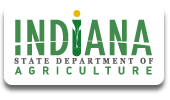The Indiana State Department of Agriculture is working with a number of our conservation partners to highlight ongoing pollinator protection and habitat expansion. The Department of Natural Resources, Natural Resources Conservation Service, the Indiana Department of Transportation, Purdue University and many in the private and nonprofit sector are doing their part to make education and information on pollinators more accessible to the public. Below you can find resources to learn more, develop your own habitat, or connect with others engaged in unique projects of their own. Visit some of our partners and discover what they’re doing to promote pollinator health and habitat.
- Getting to Know Pollinators
What are pollinators?
According to the Indiana Wildlife Federation, Pollinators are organisms that carry pollen from one flower to another. Flowering plants depend on pollinators in order to reproduce. The word “pollinator” includes any number of insects, and even some vertebrate animals (not included in this plan), that move plant pollen from one plant to another. The most commonly identified pollinators are honey bees, bumble bees, other kinds of native bees, as well as many different moths, butterflies or beetles.
What is the state doing?
The Office of Indiana State Chemist and the Indiana Pesticide Review Board are leading the charge to develop Indiana's managed pollinator protection plan (MP3). The pollinator protection plan provides protection to pollinators by better managing exposure to pesticides through changes in federal policy and possible state enforcement strategies, education, and awareness. The pollinator plan importantly provides awareness of the needs and opportunities to enhance the acreage of pollinator foraging areas that provide good nectar‐producing habitats throughout the state. The plan may address consideration of the monarch butterfly as an endangered pollinator in need of improved habitat and more access to common milkweed, a plant that is critical to its survival.
Why do pollinators matter?
According to Million Pollinator Gardens, pollinators are responsible for 1 out of 3 bites of food we take each day, and yet pollinators are at critical point in their own survival. Many reasons contribute to their recent decline. We know for certain, however, that more nectar and pollen sources provided by more flowering plants and trees will help improve their health and numbers. Increasing the number of pollinator-friendly gardens and landscapes will help revive the health of bees, butterflies, birds, bats and other pollinators across the country.
How does animal pollination work?
According to the Natural Resources Conservation Service, pollinators visit flowers in their search for food (nectar and pollen). During a flower visit, a pollinator may accidentally brush against the flower’s reproductive parts, unknowingly depositing pollen from a different flower. The plant then uses the pollen to produce a fruit or seed. Many plants cannot reproduce without pollen carried to them by foraging pollinators.
As a farmer, how can I incorporate a pollinator habitat into my farming practices?
The Indiana Conservation Partnership provides on-farm conversation practices that can also serve as pollinator habitat. Here are just a few:
What is being done nationwide?
The pollinator resources found at Xerces Society support habitat restoration in the mainland U.S. and Canada. The National Association of State Departments of Agriculture are promoting MP3s as part of a national effort to increase pollinator habitat. Another organization, Wild Ones, continues to lead the natural landscaping movement and works to explore, teach, and change the practice of gardening in communities around the country to use native plants.
- Getting Started
You can make an impact on pollinator health and habitat as well. Numerous resources exist to guide you through developing and maintaining a habitat.
Developing a habitat
Building a habitat doesn't require any special expertise and can be done anywhere; however, it is crucial to use native plants in order to avoid the growth of invasive species in Indiana. Planting natives can be done by yourself, or as simple as purchasing a previously-assembled kit online. Visit Indiana Native Plant & Wildflower Society or for a list of native plants in Indiana, click here.
Plants to avoid:
The Indiana Invasive Species Council recommends not to plant invasive species of plants. Click here for a list of which plants to avoid.
Habitat Maintenance
Maintaining a habitat is just as important as developing one. The Xerces Society recommends management tools, such as grazing, fire, and mowing, that can be used in a manner that benefits pollinators. The use of insecticides and herbicides can be harmful to pollinators; if they must be used, there are a few considerations to minimize their impact on pollinators.
For an additional resource that includes information regarding habitat maintenance and upkeep, click here.
- Getting Connected
Connect with different groups and join their efforts on pollinator habitat development. Urge your community or school to create a pollinator habitat today! Below is a list of just a few groups that are active on this issue:
- Indiana Conservation Alliance
- The Indiana Association of Soil and Water Conservation Districts
- Farm Service Agency
- Indiana Wildlife Federation
- Xerces Society
- Indiana Grown Honey Producers

- Getting Grants
There are a number of funding possibilities for habitat expansion. Below is a list that includes several organizations that have funding opportunities available:
